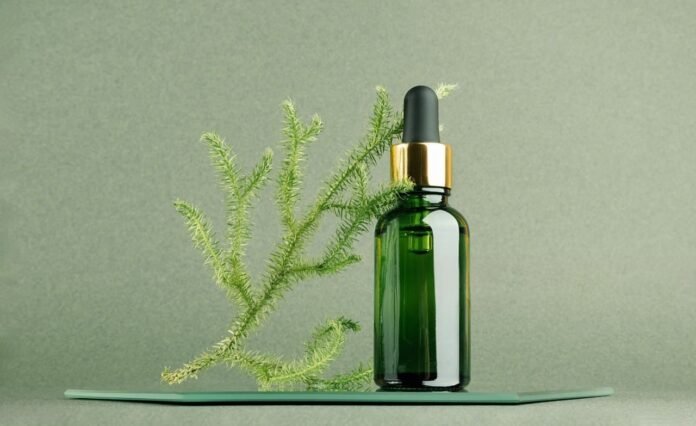Acne is a stubborn skin condition that affects millions globally, regardless of age or skin type. If you’ve tried every over-the-counter product, only to be met with more irritation, you may be overlooking a powerful natural remedy — tea tree oil.
Extracted from the leaves of the Melaleuca alternifolia plant native to Australia, tea tree oil has gained recognition for its antimicrobial and anti-inflammatory properties. But why does it deserve a spot in your acne routine? Let’s explore.
What Is Tea Tree Oil and How Does It Work?
Tea tree oil is an essential oil known for its broad-spectrum antimicrobial activity. Its main active compound, terpinen-4-ol, is responsible for killing acne-causing bacteria such as Propionibacterium acnes while also reducing inflammation and redness.
Unlike chemical treatments that strip the skin’s barrier, tea tree oil works with your skin to calm and purify it — naturally.
Benefits of Tea Tree Oil for Acne-Prone Skin
1. Fights Acne-Causing Bacteria
Tea tree oil penetrates the skin to unclog pores and destroy the bacteria that cause acne. It’s particularly effective for those with oily or combination skin, which is more prone to clogged pores and breakouts.
2. Reduces Redness and Inflammation
Inflamed pimples and cystic acne can be painful and unsightly. Tea tree oil soothes the skin, helping to shrink the size of pimples and reduce discomfort.
3. Prevents Future Breakouts
Its antibacterial properties not only clear current blemishes but also help prevent new ones from forming.
4. Helps Fade Acne Scars
Consistent use can promote healing and reduce the appearance of post-acne marks due to its ability to stimulate skin regeneration.
5. Natural Alternative to Harsh Chemicals
Unlike benzoyl peroxide or salicylic acid, tea tree oil is less likely to cause dryness, flaking, or irritation — making it ideal for sensitive skin.
How to Use Tea Tree Oil in Your Acne Routine
While tea tree oil is incredibly potent, it should always be used properly to avoid skin irritation.
1. Dilute It First
Never apply pure tea tree oil directly to your skin. Mix a few drops with a carrier oil such as jojoba oil, rosehip oil, or aloe vera gel.
2. Spot Treatment
Apply the diluted oil directly to blemishes using a cotton swab once or twice daily.
3. Add to Your Cleanser or Toner
Add a drop to your regular cleanser or toner to enhance its antibacterial properties.
4. Use in DIY Face Masks
Combine tea tree oil with natural ingredients like honey or clay for a purifying and calming face mask.
5. Nighttime Application
Using tea tree oil as part of your night routine allows it to work overnight without interference from sunscreen or makeup.
Precautions and Side Effects
While tea tree oil is generally safe for topical use, there are a few precautions you should follow:
- Patch Test First: Apply to a small area before widespread use to check for allergic reactions.
- Don’t Overuse: Using too much can lead to dryness or peeling. Stick to 1–2 times daily.
- Avoid Eye Area: Tea tree oil can irritate sensitive areas like the eyes and lips.
- Store Properly: Keep in a dark, cool place to maintain potency.
Who Should Use Tea Tree Oil for Acne?
Tea tree oil is best suited for:
- Mild to Moderate Acne sufferers
- Oily or Combination Skin types
- Sensitive Skin users looking for a gentle alternative
- Those preferring natural or organic skincare products
However, those with severe cystic acne should consult a dermatologist before use, as medical-grade treatments might be more appropriate.
Combining Tea Tree Oil with Other Skincare Ingredients
Tea tree oil plays well with many skincare staples but should be combined thoughtfully:
- With Niacinamide: Helps calm inflammation while strengthening the skin barrier.
- With Hyaluronic Acid: Balances moisture loss and prevents drying.
- Avoid with Retinol or Vitamin C (simultaneously): May lead to sensitivity or redness.
Try alternating nights if you want to use tea tree oil and retinoids or Vitamin C in the same routine.
Frequently Asked Questions
Q: Can I leave tea tree oil on overnight?
Yes — as long as it’s diluted properly. Overnight use allows the oil to fight bacteria and reduce swelling as you sleep.
Q: How often should I use tea tree oil for acne?
Once or twice a day is sufficient. Overuse can irritate your skin.
Q: Is tea tree oil safe for hormonal acne?
Yes. While it doesn’t address internal hormone imbalances, it can help manage surface inflammation and bacterial growth.
Q: How long does it take to see results?
Visible improvement typically occurs within a few days to a week of consistent use.
Summary
Absolutely — especially if you’re seeking a natural, effective, and budget-friendly solution to acne. Its antibacterial, anti-inflammatory, and healing properties make it a skincare multitasker worth having in your routine.
Whether you suffer from the occasional breakout or persistent pimples, integrating tea tree oil into your routine could be the gentle yet powerful shift your skin needs. Just remember: like any treatment, consistency and proper application are key.
If you’re ready to give your skin a plant-powered upgrade, tea tree oil might just be the secret weapon your acne routine has been missing.



